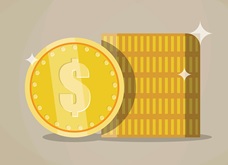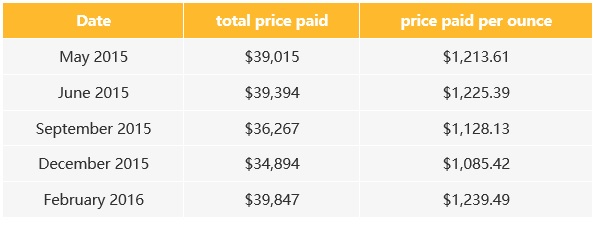Here’s A Smarter Way To Buy Precious Metals In Volatile Times

Volatility in gold and silver has been on full display the past 24 hours. As the US presidential election approached this week, gold declined $30 to $1275/oz on the prospect of a Clinton victory.
However, as initial poll results came in and were favorable for Trump, gold reversed course and rocketed higher through overnight trading. Shortly after 12 AM EST when most polling had closed, gold was up a staggering $60, to $1335/oz. Stock markets around the world were plummeting with circuit breakers triggered on US equity futures markets.
As the dust settles and Trumps victory is being digested, a sense of “normalcy” is returning to markets. Gold and silver have given back gains, and US stock markets have moved into positive territory… although bond yields remain elevated, perhaps indicating higher inflation and interest rates are on the horizon.
Two steps forward, one step back.
With “Brexit” earlier this year, constant messaging from the Federal Reserve, and now the presidential election, gold and silver have gyrated wildly. It can be a frustrating pattern in the precious metals market, especially when taking a position after a sustained rally.
But the only thing worse than buying the day before a down day, is not buying at all.
A lot of investors have been waiting for a correction to purchase gold and silver for most of 2016. They wait, and they wait, and they wait. And metals move up and down and up again.
What is all the waiting for?
It is very hard to buy only on down days and nearly impossible to pick a market bottom. It’s not necessary either. Plenty of investors who have been consistently buying all along are paying the same (or even less) in the long run for their metal.
Why? Because they’re leveraging market volatility and external developments to dollar-cost average into a position.
Making Volatility Work For You
Part of what makes dollar-cost averaging your investment so tough is that it requires patience (and a strong stomach).
Have you ever picked a specific spot price to signal your time to buy, but when prices went there, you kept waiting because you thought they’d drop more? You’re not alone.
Whether markets fluctuate up or down is a minor consideration when it comes to dollar-cost averaging your purchases.
The main thing is that you're consistently building your precious metals holdings while taking advantage of market movements.
It’s steady, methodical, and takes all those pesky emotions out of investing.
Let us look at an HAA client who purchased his allocation to gold from May 2015 to Feb 2016. Here are the purchase amounts (including fees) and dates, each for 1 kg gold bar:

Total ounces purchased: 160.74
Total money spent: $189,417
Average price paid: $1,178/oz
This client knew how much he wanted to spend but was unsure when to buy due to the recent bear market in gold (and many analysts predicting sub $1,000 prices).
By taking a longer-term approach to the purchase process, he was able make several purchases near gold's low of $1,050 and finished the process with an average price near the low end of gold's trading range during the time. Yet, he saw spot prices as high as $1,230 and low as $1,050.
While this does require some patience and watching the market, it can be an effective strategy.
We all want to get into an investment at the right time and at the best price. But as you can see, the “right” time and the “best” price are both relative.
Precious Metals Are the Perfect Asset to Average Into
If you’re buying metal for the right reasons, dollar-cost averaging your position makes good sense. Consider why it works for gold:
- Gold is a safe-haven asset. Just as you don’t check the market value of the real estate that you own every week, you don’t need to track short-term fluctuations in metals prices. You’re buying gold to hedge risk with a hard asset. Sure, you could profit from its resale, but its intangible return (insurance) is what you’re after.
- Metals are time proven to hold value. Gold is immune to the corrosive effects of inflation. Its purchasing power will remain intact 10, 20, or even 40 years from now. By then, a $50 difference in the purchase price of your first piece of gold and your last isn’t going to matter.
- The gold market is small. When the next financial crisis takes its toll, investors will scramble to gold (they always do). That squeeze on supply will send prices soaring. Right now, we’re seeing geopolitical, cultural, and technological forces posing an imminent threat to the global economy. If you start stockpiling while we’re still in a bear market, you’ll be buying when even the highs are relative lows.
How Much And How Often To Buy
The question many investors ask themselves is, what is the “right” way to average into a position?
The answer is up to you and how you feel about risks and returns in other markets. First, you must decide the amount of precious metals you want to own, then divide your capital into equal dollar amounts and spread the purchases out over time.
If you’re uncertain about the near-term direction of gold, the safest way to go is smaller, more frequent investments, but this takes more legwork if you don’t have the option to automate your purchases.
Working with a dealer that allows you to schedule a monthly investment offers a simple, cost-effective way to grow your holdings incrementally.
When it comes to precious metals investing, waiting for the bottom is a fools errand. We never know how long a price drop will last, or how deep it will go.
All signs point to a coming bull market for gold. If you keep watching precious metals prices and waiting to move on investing, you risk being shut out of the market altogether.
Stop waiting to get into the precious metals market!
********
Free Ebook: Investing in Precious Metals 101: How to buy and store physical gold and silver
Download Investing in Precious Metals 101 for everything you need to know before buying gold and silver. Learn how to make asset correlation work for you, how to buy metal (plus how much you need), and which type of gold makes for the safest investment. You’ll also get tips for finding a dealer you can trust and discover what professional storage offers that the banking system can’t. It’s the definitive guide for investors new to the precious metals market. Get it now.
















